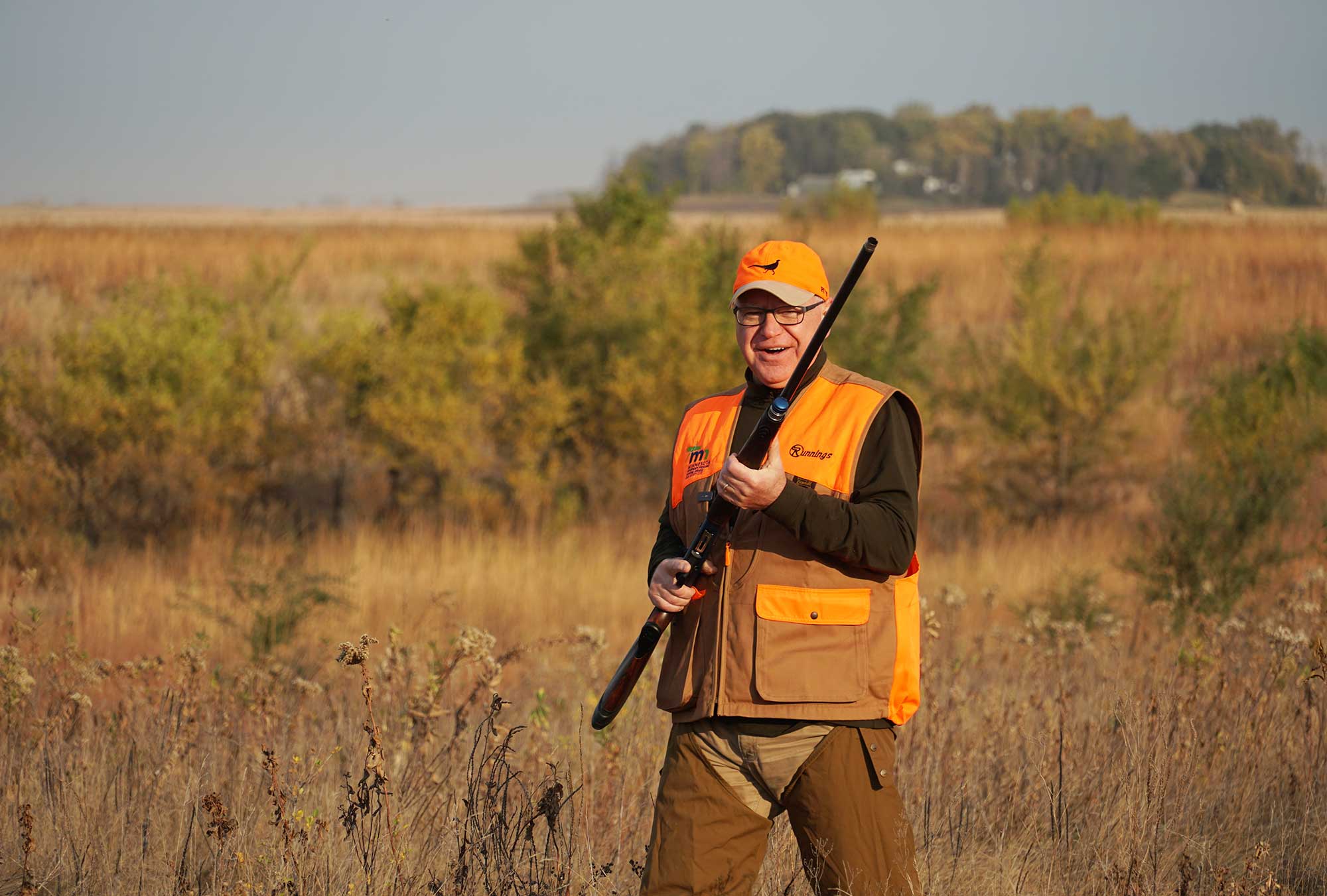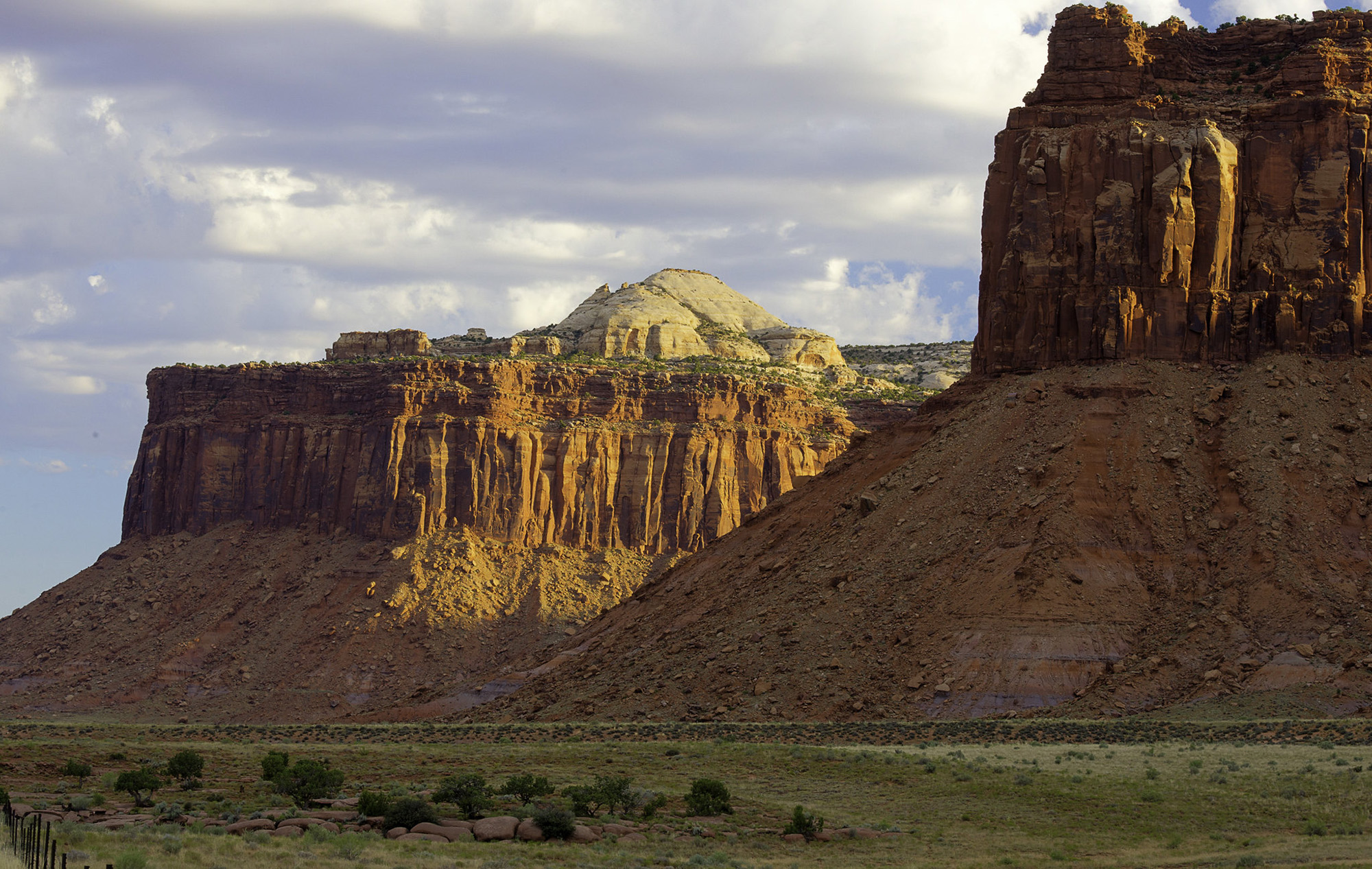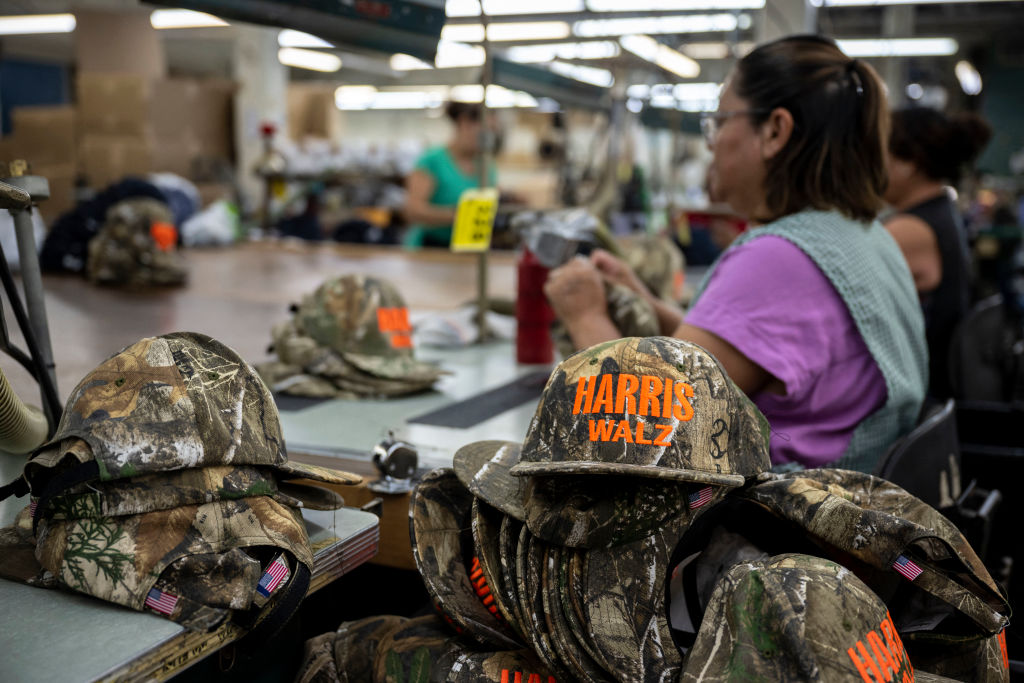Here’s What a Harris-Walz Administration Might Mean for Outdoorsmen, Conservationists, and Gun Owners
We may earn revenue from the products available on this page and participate in affiliate programs. Learn More ›
Editor’s Note: This is the second of a three-part series covering the presidential election and how each administration’s policies might impact outdoorsmen and gun owners. Part one focused on how (and why) Outdoor Life covers politics. Part Three will examine a potential Trump-Vance administration.
Democratic presidential candidate Kamala Harris has been explicit: If elected, her administration will not be a cut-and-paste version of the Biden administration, in which she served as vice-president.
For many conservation leaders, that’s a welcome statement. After four years of a Trump presidency that, while chaotic and fractious, was actually pretty good for core hunting, fishing, firearms, and conservation issues, the subsequent Biden administration was generally a disappointment for American sportsmen and women.
“[During] Trump’s administration, there was genuine concern that his Interior Secretary would turn Western lands into gas fields and his Agriculture Secretary would let Big Ag run our Farm Bill. We expected the Biden administration would be overall good for conservation,” said the CEO of a sportsmen’s organization who asked not to be named. Because most non-profit conservation groups are prohibited from endorsing or even commenting on political candidates, many talked to Outdoor Life on the condition that neither their names nor the names of their organizations would be used in election-season reporting.
“But [under Biden] we got climate policy instead of hunting-and-fishing policy, we got tribal co-management of public lands instead of reinvesting in infrastructure of the BLM and the National Wildlife Refuge System, and we got policies built around biodiversity and social justice instead of wildlife habitat and public access.”
Harris’ campaign says it’s unfair to judge her potential presidency, with Minnesota Gov. Tim Walz as vice-president, as a continuation of a Biden administration.
So how might a Harris-Walz administration manage America’s public lands, wildlife resources, and natural-resource agencies, and what would the conservation priorities of a Harris-Walz administration look like? And importantly, what firearms laws and restrictions might a Harris-Walz administration look to implement?
Most of those are big unknowns that aren’t expected to be answered before the election in just two weeks, partly because Harris has been a presidential candidate for only 100 days, and partly because sportsmen’s issues aren’t driving most national dialogue around the presidential race
But here’s what we know — and what our sources speculate about — the Harris-Walz ticket on a number of issues important to America’s hunters, anglers, shooters, and conservationists. We’ll detail the Trump-Vance campaign’s stance on these issues in a subsequent piece.
Harris-Walz on Firearms and the Second Amendment

Photo by Alex Robinson
Harris’ perspective on firearms possession and ownership have caught the attention of hunters, shooters, and gun owners, but also police chiefs, school superintendents, and gun-violence-prevention activists. A former district attorney and California attorney general, she has been characterized both as “tough on crime” by fellow prosecutors and soft on gun ownership rights by the NRA. She has called gun violence in America, where guns are the leading cause of death in children under age 18, an “epidemic.” And she has guided the Biden administration’s gun policy as she oversees the White House Office of Gun Violence Prevention.
Despite Harris’ long history of working on gun policy, which has included wonky provisions for gun buybacks, stricter restrictions on gun ownership with universal background checks, and investment in mental health resources, Lawrence Keane has a quick read on her objectives.
“She’s a gun-grabber, what more do you need to know?” says Keane, senior vice president for governmental affairs at the National Shooting Sports Foundation. “She thinks banning guns will make us safer. It doesn’t make us safer. The industry isn’t the bad guys. Responsible gun owners aren’t the problem. We’re part of the solution.”
But others think that’s a rush to judgment.
“I think the characterization that some in the hunting and shooting and gun-rights community have of her as an anti-gun candidate is exaggerated,” says Patrick Berry, CEO of Backcountry Hunters & Anglers. “But it’s also understandable, because we haven’t heard much of her wider conservation priorities, or what she would emphasize if she’s elected.”
National Assault Weapons Ban
Harris’ documented stance on most firearms policies is informed by her desire to reduce gun violence, from high-profile school shootings to suicide to crimes enabled by guns. To achieve that goal, she would generally attempt to restrict the number and type of firearms sold in America, and impose requirements on gun owners.
The biggie, according to most campaign-watchers, is a reinstatement of the 1994 ban on “assault-style” weapons. Harris made comments in September calling for return of the federal ban that would restrict sale and distribution of the AR-15 platform, the weapon often used in high-profile mass shootings and also the most-purchased type of firearm in America. Any measure that ends sales of these guns seems even more extreme now since the magazine-capacity and cosmetic attributes covered in a ban — not to mention the platform itself — are more normalized than they were when the ban took effect during the Clinton administration. The 1994 ban expired in 2004, and many hunting and firearms-rights groups have made it a main goal to avoid any future bans.
Among the other sporting firearms that might be included in a ban are some semi-auto turkey shotguns with pistol grips, rifles with extended magazines, and guns with flash suppressors and certain muzzle brakes.
It’s worth noting that an assault weapons ban implemented through executive order would probably face legal challenges and could come before the conservative Supreme Court, which overturned a Trump ban on bump stocks on the grounds of administrative overreach.
An assault weapons ban is likely only part of a Harris administration’s approach to reducing gun violence. Other measures could include extension of red-flag laws, safe storage laws, and investments in mental-health screening and therapy intended to reduce not only mass shootings but also the high rate of suicide by firearm in America. She is also likely to continue the White House Office of Gun Violence Prevention, which some pro-gun groups think gave gun-control organizations undue access and influence over administration policy.
Harris said in a White House speech in September that “it is a false choice to suggest that you are either in favor of the Second Amendment or you want to take everyone’s guns away. I am in favor of the Second Amendment, and I believe we need to reinstate the assault weapons ban and have universal background checks, safe storage laws, and red flag laws.”
Harris supported an executive order Biden signed in September that creates a new “emerging firearms threats task force” that will crack down on rapid-fire bump stocks and unserialized 3D-printed firearms parts. She also supports universal background checks for gun purchases, extending enhanced federal checks to gun buyers under the age of 21, and expanding the government’s collection of gun-violence data.
Harris as a Gun Owner
Kamala Harris is a gun owner. She made that public declaration first in her unsuccessful 2019 presidential campaign, and again in her September debate with former president Trump. She owns a Glock semi-auto handgun, and she said later in an interview with CBS’s 60 Minutes that she shoots it at a range, and that she owns it for personal defense. It’s unclear what model Glock she owns, or if it’s a version that’s legal to possess in California, where she was an assistant district attorney, a district attorney, and later the state’s attorney general. While she’s gotten heat for owning a handgun in gun-restrictive California, most states allow a possession exception for active law enforcement officers, including states’ attorneys.
That’s not enough for Keane, himself a former prosecutor.
“Most DA’s carry briefcases, not handguns,” he says. “I’m not saying Harris isn’t qualified to carry, but her statement that she owns a gun raises at least as many questions as it answers, especially if she claims she acquired it in the furtherance of her official duties. I’d have to ask, what official duties?”
Beyond the personal, Keane and other pro-gun activists are troubled by Harris’ role overseeing the Biden White House’s Office of Gun Violence Prevention, which has pursued policies aimed at curbing gun violence by revising public school active-shooter drills, enacting red-flag laws to temporarily confiscate guns from owners deemed a societal risk, and placing restrictions on “ghost guns,” firearms that can be assembled from unserialized parts, as well as gun parts that can convert semi-automatics to fully automatic operation.
Restrictions on gun ownership are ineffective, says Keane, who believes Harris will perpetuate the Biden administration’s “cozy” relationship with gun-control groups like Everytown and former congresswoman Gabby Giffords’ organization focused on reducing gun violence in America.
“She’s a hard-core anti-gun,” says Keane. “She’s never seen a gun-control measure she didn’t support. She’s in favor of confiscation. She calls it ‘mandatory buy-back.’ Well, in my book that’s confiscation.”
Walz on Guns
Harris’ running mate, Minnesota Gov. Tim Walz, has been mocked for what appears to be his awkward handling of his shotgun, a semi-auto Beretta, during the Minnesota pheasant opener. But Walz, who grew up in rural Nebraska and is a life member of Pheasants Forever, is a former recipient of the NRA’s “A” rating on gun issues, and as a congressman and co-chair of the Congressional Sportsmen’s Caucus, was frequently top gun at the Congressional Sportsmen’s Foundation clays shoot.
“He had a bad moment when the cameras were rolling,” said another unnamed conservation leader of Walz’s Minnesota pheasant hunt, “but I’ve shot [trap] with and against him, and he definitely knows how to handle a shotgun.”
Walz, who appears to be the campaign’s point person on hunting, conservation, and gun issues, has reiterated his support for temporary red-flag confiscations as well as his support for an assault weapons ban. As Minnesota governor, Walz has proposed temporary protection orders in certain circumstances.
“Expanded background checks and especially the extreme risk protection orders are two things that don’t infringe on your Second Amendment rights,” Walz told Outdoor Life following the Minnesota pheasant hunt. “They make great sense. And we know especially with the extreme risk protection order, a lot of that is families protecting folks from suicide.”
Walz, who received an “F” rating from the NRA during his 2018 gubernatorial race, says it’s incorrect to call temporary protection orders a “confiscation” of firearms. Along with temporary removal of guns from an at-risk owners’ household, the measures provide a legal mechanism to allow owners to regain access to their firearms once the risk has passed.
“We’ve had the extreme risk protection order implemented multiple times in Minnesota,” says Walz. “Sometimes you’re proving a bit of a negative, but I’m convinced we probably saved folks [by intervening].”
Walz says that, instead of “grabbing guns,” a potential Harris administration wants to devote more resources to understanding the cause and effect of firearms-related fatalities, starting with removing prohibitions on research that might quantify the extent of gun violence in America.
“I think the industry is making a huge mistake [in supporting limits on research] because the public is overwhelmingly against them. Look, I buy their products. I’m a gun owner. But when one of the top three causes of death of our children is firearms and yet we can’t research what’s behind it, what do they fear doing the research on?”
An assault-weapons ban, which could include semi-automatic shotguns with pistol grips and extended magazines, AR-style rifles with 30-round magazines, and guns with folding stocks, wouldn’t restrict most traditional firearms, says Walz, who also advocates mandatory safe storage of firearms.
In the context of mass shootings in America, says Walz: “I think all of us need to recognize there can’t just be an endless have whatever you want. [There are] countries that have firearm rights — Finland as an example — but they don’t have these mass shootings. Just put a trigger lock on your weapon. Now, that doesn’t infringe upon your Second Amendment, and it keeps your children safe.”
Lead-Ammo Restrictions

Photo by Bob Wick / BLM
While Harris has taken no public stance on banning lead ammunition, there are enough actions made by the Biden administration to cause concern among some hunting organizations that wider restrictions on lead bullets might be in the offing. That could be a change from the current arrangement in which lead ammunition is mainly discouraged (it’s banned on others) on many federal properties, but instead of a wider ban, hunters and shooters are educated about the environmental impacts of lead and incentivized to switch to non-lead projectiles.
“Looking ahead to a possible Harris administration, I could see a scenario where bans on lead ammo move beyond hunting and start to be applied to recreational shooting,” said a conservation leader who asked not to be named because of their expectation to work with either administration. “And I can foresee additional closures of BLM and U.S. Forest Service land to recreational shooting.”
That perspective is rooted in two recent high-level executive actions by the Biden administration. The first, included in the U.S. Fish and Wildlife Service’s “Hunt Fish Rule” governing approved activities on national wildlife refuges, is a “mixed bag” for sportsmen because while the USFWS proposed opening an additional 112,000 acres of federal wildlife refuges to hunting, rules would require hunters to use non-lead ammunition on the newly opened properties.
The second is this month’s release of the final draft of the Bears Ears National Monument management plan in Utah. That plan, developed in partnership with five Southwest tribes, bans all recreational shooting on the 1.3-million-acre monument.
The outright ban on one type of recreation on a high-profile federal property shows the Biden administration’s “anti-gun, anti-hunting agenda,” says NSSF’s Keane, who contends that the Bears Ears shooting ban violates Congress’s Dingell Act, which requires any shooting restriction on federal land be as small in size and temporary in duration to protect cultural resources.
Harris-Walz on Hunting Access, Habitat Conservation, and Public Lands

(Photo by ANGELA WEISS / AFP)
Neither presidential campaign has been especially vocal about prioritizing hunting, angling, and conservation platforms, though the Harris-Walz campaign did launch a coalition — Hunters & Anglers for Harris-Walz — last week. The specific priorities articulated on the campaign’s website include conserving wild places, expanding outdoor opportunities, and protecting the Second Amendment.
But those are pretty thin and unsurprising policy prescriptions to sustain an outdoor recreation industry that last year alone generated $3.3 billion in hunting and fishing licenses and tax revenue from the sale of guns, ammunition, and fishing tackle. Especially considering longer-term trends — loss of wildlife habitat and traditional recreation access, declining biodiversity, changing climatic trends, and ballot initiatives and regulations that increasingly prohibit or discourage traditional hunting and trapping — most conservation leaders are looking for more resolute signs a Harris administration is heeding, or even hearing, their priorities.
Those goals are outlined in an influential briefing paper, Wildlife For the 21st Century, that includes issues and consensus policy recommendations from 52 conservation organizations that call themselves American Wildlife Conservation Partners. The document has been developed every four years since 2000 and is a well-considered and detailed set of priorities. This year’s version, shorthanded to W-21, was distributed to both presidential campaigns in September, says Taylor Schmitz, director of federal relations for the Congressional Sportsmen’s Foundation and W-21’s chairman.
It’s unclear whether either campaign has developed policy statements or positions based on W-21.
A Focus on Green Energy and Biodiversity
Just about the only on-the-record evidence that Harris would support traditional hunting and fishing activities is her campaign’s commitment to “expanding outdoor opportunities” noted on the hunting and fishing coalition website.
Would a Harris administration continue to support private-land habitat easements, as the Biden administration has done? Without a renewed Farm Bill, these alternative programs provide habitat and, in some cases, recreational access. Would a Harris administration continue to promote expansion of hunting and fishing opportunities on refuges and other public lands?
Because there’s so little on the record, conservation leaders are basing some of their expectations of a Harris administration on Biden’s record, but they’re generally sanguine in their assessments.
“I think we have to expect a heavy focus on biodiversity and climate change” in policies across federal agencies, said a conservation leader. “I think we see continued expansion of solar and wind development, potentially in unfragmented sage-steppe and grassland ecosystems.”
Earlier this year the BLM released its plan for solar-energy development on Western public lands, and while conservationists generally fear widespread fossil fuel extraction under a Trump administration, they’re equally worried about widespread renewable-energy facilities on fragile rangelands.
Insiders point out that the next president might not have the last, or even the first, word in funding for large-scale conservation projects.
“Depending on the makeup of Congress, there could be significant investments into conservation,” said the leader. Nobody we talked to thinks the expired Farm Bill will become law before the new president is inaugurated. The Farm Bill provides roughly $6 billion annually for conservation, mainly on private lands, and the last federal infrastructure bill provided over $40 billion over five years for access, conservation, and capital improvements to federal facilities. But if a Republican Congress balks at spending, there could be relatively little federal money available for conservation work.
The Biden administration has poured billions of dollars into conservation work. Most of it was passed as “climate resiliency” work under the auspices of the $670 billion Inflation Reduction Act, passed by a deadlocked Senate on vice president Harris’ tie-breaking vote. The Department of the Interior has been distributing its $6.4 billion share of the funds to partners (like the Mule Deer Foundation, National Wild Turkey Federation, and Backcountry Hunters & Anglers) to do wildfire mitigation and habitat stewardship work, to address water-delivery infrastructure across the drought-prone West, and to restore impaired ecosystems. That huge amount of money is unlikely to be available again in the near future.
While some wildlife conservation leaders are confident a Democrat president will support large funding packages, others are mindful that the Biden administration whiffed on an opportunity to support traditional hunting and hunters in a controversial wildlife refuge plan, called BIDEH for short, earlier this year. BIDEH prioritizes top-down management at wildlife refuges, and de-emphasizes water control strategies that benefit huntable waterfowl while emphasizing natural processes that benefit non-game species.
“BIDEH was really a chance to affirm to the hunting community that the Biden administration had our back, and instead we got a plan in which the role of hunting and hunters — that paid for most of these federal refuges, by the way — was minimized,” said the CEO of a conservation organization who asked not to be named.
Under the Biden administration, sportsmen have also seen big-game hunting closures on more than four million acres of federal land in Alaska and an unwillingness to remove federal protections for grizzly bears and wolves, even in areas where the endangered species have surpassed recovery goals.
Walz on the Record

Larry Keller, Getty Images
In his interview with Outdoor Life, Gov. Walz said a Harris-Walz administration would uphold traditional conservation programs and funding mechanisms.
“What you would see is upholding the Pittman-Robertson Act and obviously leaning into the conservation title of the Farm Bill, which is our great working lands bill,” Walz told Outdoor Life. “Both of these are models for the rest of the world.”
Walz noted the provisions of the controversial Project 2025, a document compiled by the conservative Heritage Foundation that calls itself the “presidential transition project” for an incoming Republican candidate, presumably Trump.
“[Our position] is in contrast to Project 2025 and getting rid of CRP and the conservation titles of the Farm Bill,” Walz said. “I can’t even believe that there are Republicans who would think that’s not ridiculous, because my ag producers, they love [the CRP program]. And if we’re gonna ask [farmers] to take marginal lands out of production, that costs them income and we all benefit from it. That’s the beauty of this… We share in it. We all are protecting it and the farmer should get that [revenue]. That’s not a subsidy to the farmer. That’s a way to protect these lands.”
There appears to be another point of differentiation between a Harris-Walz and Trump-Vance administration. Many Western Republicans, along with Vance, have promoted the idea of alleviating America’s shortage of affordable housing by developing homesites on federal land near urban centers. It’s an idea that’s been hotly opposed by public-land advocates who claim that privatizing public land is short-sighted and would benefit wealthy real estate developers.
“You heard Senator Vance in the debate say they’re gonna build houses and drill on federal lands,” Walz told Outdoor Life. “I don’t know how that’s going to work. I don’t know where those federal lands are around Minneapolis, and we know that the federal lands are the ones that are most protected and they are for our use.”
In his debate response after Vance proposed the idea of developing federal land for affordable housing units, Walz pushed back on the idea, calling himself “someone who cares deeply about our national parks and our federal lands.”
It should be noted that Harris has also proposed repurposing federal lands for housing.
One source noted that when he was in Congress, Tim Walz was “generally very good on our [conservation] issues. He was a traditional Midwest moderate Democrat, good on rural issues and generally pretty moderate on social issues.”
Not all Minnesota outdoorsmen view Walz as a moderate, and the Minnesota Deer Hunters Association withdrew support from the Governor’s deer hunt in 2023 due to his stances on firearms restrictions and wolf management. However, in his interview with Outdoor Life, Walz leaned into his moderation.
“Having served in Congress, having been the co-chair of the Sportsmen’s Caucus, [I worked on] expanding that caucus, talking about the economic impact that outdoor activity makes for this country. It’s bigger than pharmaceuticals and auto manufacturing. I think you’ll see this, and you saw it for me as governor, I think the vice president talks about this, this ability to work with producers on those working land bills that work best.
“We’ve done it here [in Minnesota]. We have a voluntary ag water quality certification project. We’ve enrolled over a million acres of marginal land near waters that farmers themselves have voluntarily set aside. Walk-in access is critical. We’re very proud of that here in Minnesota … One of the things with hunting, you have to have access. If you’re not a landowner, that’s a barrier. I saw that once I moved to Mankato [Minnesota]. When I was in Nebraska, all of the land [I hunted] was either my family’s or neighbor’s. So I think, I would certainly council that we [should support walk-in-access].”
Walz also told Outdoor Life that he intends to help a Harris administration build durable coalitions to keep hunting and recreational shooting access as part of federal-land management plans.
“As a member of Congress, I of course supported it. The one issue was and is the lead [ammo] on the firing ranges. But we expanded the [congressional] Sportsmen’s Caucus because it used to be [just] the hook and bullet guys. We expanded it to backcountry horsemen, Trout Unlimited, mountain bikers to say, look, we can share this land together and we’re all gonna get pushed out if we don’t figure out how to make this work for all of us.”
Walz says he would resist gun restrictions on federal lands.
“I understand the tension, and the argument that some people don’t want guns on federal land, but I get it as a hunter. If we don’t have [federal land access] and either state access or some of these access [programs], it’s very difficult.”
Backcountry Hunters & Anglers CEO Berry says public-land management is a good litmus test of the presidential candidates.
“I would hope that either administration — any administration — would affirm their commitment to maintaining America’s public land system, whether it’s BLM or Forest Service or National Wildlife Refuge. I think that should be a starting point regardless of party affiliation. These are resources that will continue to give future generations the opportunity to value our shared natural heritage.”
But Berry says guns and the right to hunt and fish should also be litmus tests of a candidate.
“I would hope a future administration would affirm their uncompromised support for hunting as the most socially, ethically, and environmentally responsible way to put meat on your table, but also as an irreplaceable conservation tool in managing wildlife resources and maintaining the integrity of natural systems that support all wildlife. That shouldn’t be a partisan issue, either.”
— Alex Robinson contributed reporting to this story.
The post Here’s What a Harris-Walz Administration Might Mean for Outdoorsmen, Conservationists, and Gun Owners appeared first on Outdoor Life.
Source: https://www.outdoorlife.com/conservation/harris-walz-administration-hunting-conservation/




